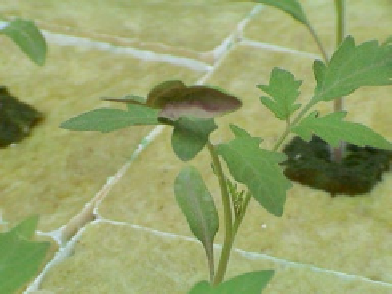Agriculture Reference
In-Depth Information
Fig. 10.11
Anthocyanin
formation on the underside
of the tomato transplant
leaves caused, due to a worse
uptake of phosphorus at low
temperatures. (Source: Gruda
2005
, private collection)
instance, the red color of ripe tomato fruits is attributed to lycopene, a carotenoid
synthesized and stored in the chromoplasts. Dumas (
2003
) reported that, except for
β
-carotene, greenhouse-grown tomato plants reduced carotene content of the fresh
fruit under lower temperature regimes and at low air temperatures of < 12 °C may
fully inhibit lycopene production. Moreover, Zipelevish et al. (2000) reported that
eggplants (
Solanum melongena
) grown under cool winter conditions in unheated
polyethylene covered greenhouses displayed a weaker intensity of fruit skin colour
than during the normal hot growing period.
Low temperatures could also directly influence the organoleptic properties of
vegetable products. For instance, low temperatures will produce less juicy tomato
fruits with low acidity content and a mealy taste (Brückner et al.
2004
) with Kano
and Goto (
2003
) reporting a higher occurrence of bitter fruits in cucumber (
Cucu-
mis sativus
cv. 'Kagafutokyuri') when grown under lower temperatures rather than
higher temperatures. Both water and nutrient uptake can be inhibited at low tem-
peratures. Jansen et al. (
1989
) reported that water absorption of cucumbers at 5 °C
in the root zone is only about 10 % compared to that at 20 °C. In addition there can
be a drastic reduction in absorption of nutrients at low temperatures in warm-season
plants. Low temperature greenhouse grown tomato seedlings exhibited a lack of an-
thocyanin formation on the underside of the leaves due to a reduction of phosphorus
uptake (Fig.
10.11
). Once the seedlings are placed in the heated greenhouse, these
symptoms gradually disappear.
Low temperatures make plants more susceptible to some pathogens and under
such conditions inhibit the plant's defense mechanisms.
On the other hand, sub optimal low temperatures, when used appropriately, can
sometimes improve fruit and vegetable quality. Ventura and Mendlinger (
1999
), for
instance, reported that melon fruits from the unheated greenhouses were smaller
and lighter than those from the heated greenhouse and had higher amounts of total
soluble sugars (TSS), sucrose and fructose and tomatoes showed an improvement
in fruit carbohydrate accumulation (fructose and glucose) when harvested under
cooling growing conditions (Islam and Khan
2001
).

